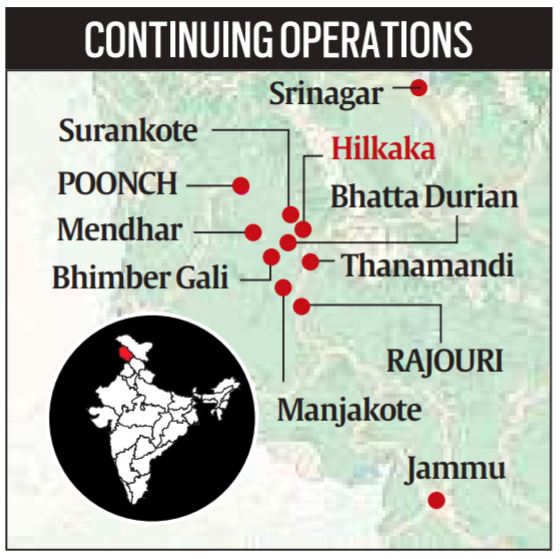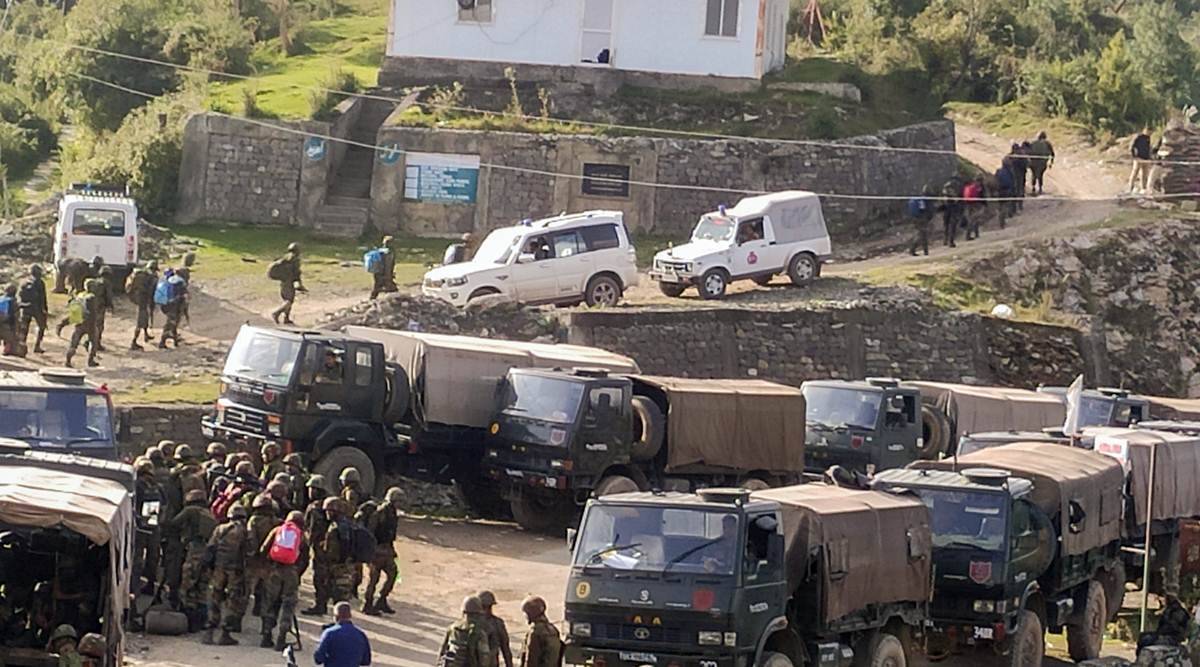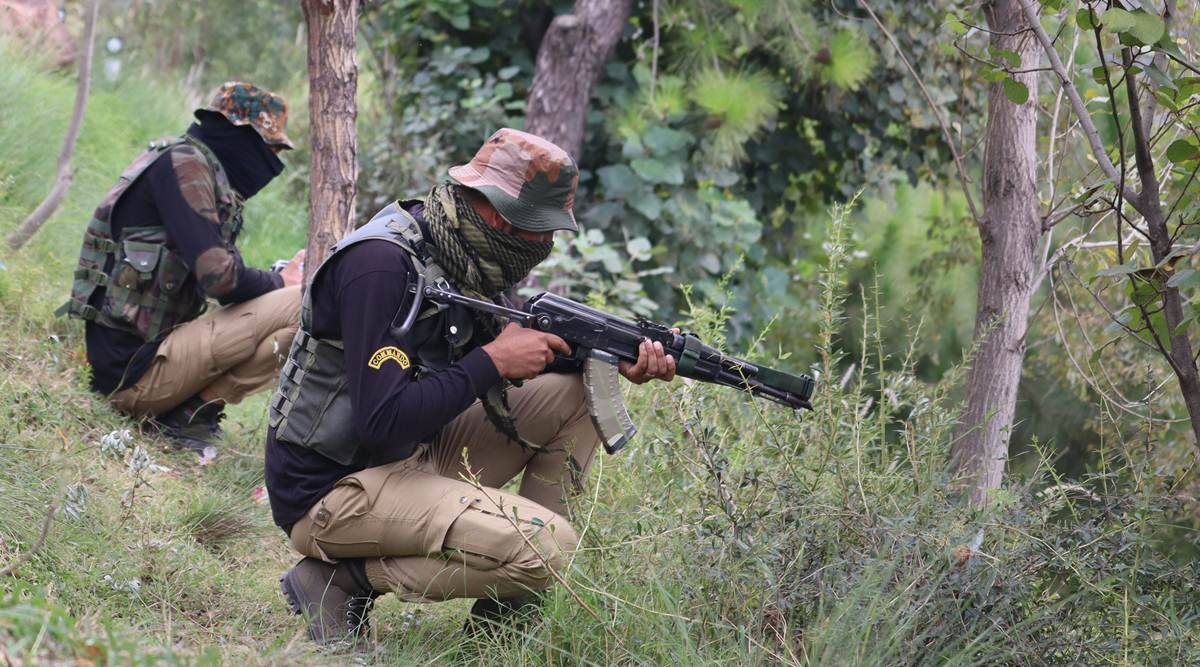- India
- International
Army’s counter-terror op in Poonch recalls strike in Hilkaka 18 years ago
Pakistani jihadists had turned village in Surankote tehsil, about 10-12 km inside the LoC, into a militant stronghold that was finally destroyed in Operation Sarp Vinash.
 In the Nar Khas forest area of Poonch district on Wednesday. (PTI)
In the Nar Khas forest area of Poonch district on Wednesday. (PTI)The ongoing operation against militants holed up high in the Poonch ridges in Jammu is the longest in the area since 2003. There is no clarity about how many militants the Army is fighting, and how long they have been hiding in the thick forests on the Pir Panjal spurs that overlook the districts of Poonch and Rajouri.
Cross-border infiltrators have long been known to use the Poonch-Pir Panjal route to access South Kashmir. But they are not known to stay on in the area for long, because of its mixed Hindu-Muslim population that is hostile to both Pakistani and Kashmiri militants.
This is the reason the possible presence of militants for weeks in the area has raised red flags in the security establishment. It has also evoked comparisons with a time when Poonch was a hotbed of militancy, and a security nightmare. It took a long drawn operation in 2003 to clear out the militants — and much longer to win over the local people.
A base for Pak terrorists
The target of these operations was a place called Hilkaka. Scores of Pakistani militants had infiltrated across the Line of Control (LoC) in Poonch and dug in for the long haul at Hilkaka, a Bakerwal village in Surankote tehsil, about 10-12 km inside the LoC.
The Pakistani terrorists, belonging to the Lashkar e-Taiba, Jaish-e-Mohammad, Al-Badr and some other groups, had turned the village into a fortress of their own. They had converted hundreds of dhoke (cattle sheds used by the Bakerwal for their animals) on the steep slopes into bunkers reinforced with concrete and stone, built other fortifications including a hospital, and stored rations to feed 500 men for two months.


Starting from 1999, the Pakistanis virtually ran a parallel administration in the area — until 2003, when the Army decided to flush them out.
Crushing the snakes
There had been several encounters in the area before the Army carried out Operation Sarp Vinash between April and May 2003. The clearing of Hilkaka was the biggest counter insurgency operation in Jammu & Kashmir until then.
With memories of the 1999 Kargil war still fresh, and the Army recovering from Operation Parakram, the massive mobilisation after the December 13, 2001 attack on Parliament, there were concerns that the terrorists in Hilkaka could interdict Army logistics from reaching the LoC in case of an outbreak of hostilities with Pakistan.
Preparations for an all-out assault began in January 2003. The operation took place in a 150-sq-km area between three major ridges, on the western spurs of the Pir Panjal.
Some 15,000 troops — the size of a division or three brigades — were involved in the operation that lasted about two weeks.
Mi-17 helicopters were used to airlift troops to Hilkaka, and Lancer attack helicopters were used to bust concrete bunkers at high altitudes.
 Security forces at Surankote in Poonch. (PTI)
Security forces at Surankote in Poonch. (PTI)
According to the Indian Army, the total number of militants killed was 62. The troops were said to have recovered AK-47 rifles, PIKA guns, sniper rifles, grenade launchers, self-loading rifles, explosives, and a large number of radio sets and other communications equipment.
The Army lost two soldiers. During the operation, the government of the erstwhile state of J&K paid a compensation package of Rs 7.5 crore to the Bakerwal herders who were ordered to keep off the area.
Unanswered questions
Later, efforts were made to beef up the presence of the civil administration in the area. Roads were built to provide connectivity. The Army made special efforts to reach out to the Gujjar-Bakerwal population in the area. Many of the local people got work with the Army as porters.
The ongoing operation in Bhatta Durian of Balakote tehsil of Poonch, which enters the eleventh day on October 21, is much smaller than Sarp Vinash.
The number of militants present in the area is thought to be no more than eight, if not fewer. But it is the first long stand-off in the area since the time the Hilkaka remnants were mopped up.
 Army personnel at the encounter site in Mendhar, Poonch, on Sunday. (PTI)
Army personnel at the encounter site in Mendhar, Poonch, on Sunday. (PTI)
The possibility that in 2021, a group of terrorists has entrenched itself in the same area for over two months, killed nine security forces personnel, and continues to evade sighting, has raised concerns that cross-border efforts are on to revive militancy in the area.
Security officials said that only after the area has been cleared would they be able to understand how long the militants had dug themselves in, how they had sustained themselves, how much, if any, local help they had received, and how they had managed to evade detection.
The area is well inside the LoC, and is patrolled by the Romeo Force, a division of the Rashtriya Rifles.
Newsletter | Click to get the day’s best explainers in your inbox
More Explained
EXPRESS OPINION
Apr 25: Latest News
- 01
- 02
- 03
- 04
- 05










































